#2024 technology
Explore tagged Tumblr posts
Text
Happy New Year 2024 from Korea.
Year of the 🐲🐉!
#Seoul#korea#happy 2024#new year#drone show#drone#fireworks#amazing#video#viral#3d#technology#🎇#nature#space#Star#night#earth#awesome#tumblr#hd#dragon#dragon year#chinese#tradition#art#love#moon#animal
104K notes
·
View notes
Text
#powerbi#clarion technology#technology#development#developer#web development#2024 technology#app development
0 notes
Text

Our newest class of astronaut candidates graduated on March 5, 2024. This means they’re now eligible for spaceflight assignments to the International Space Station, the Moon, and beyond! In the next twelve posts, we’ll introduce these new astronauts.
youtube
Do you want to be a NASA astronaut? Applications are now open.
Make sure to follow us on Tumblr for your regular dose of space!
#NASA#astronaut#NASA Yearbook#graduation#Class of 2024#space#Inspiration#tech#technology#dream job#Youtube#STEM
16K notes
·
View notes
Text
Here's the top 2 stories from each of Fix The News's six categories:
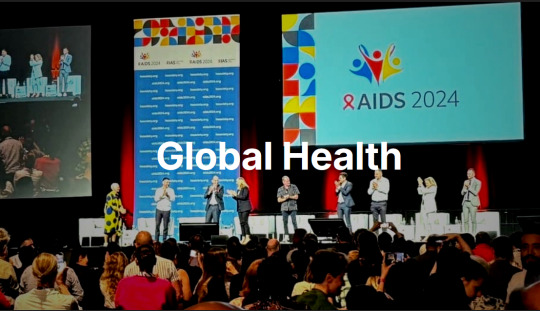
1. A game-changing HIV drug was the biggest story of 2024
In what Science called the 'breakthrough of the year', researchers revealed in June that a twice-yearly drug called lenacapavir reduced HIV infections in a trial in Africa to zero—an astonishing 100% efficacy, and the closest thing to a vaccine in four decades of research. Things moved quick; by October, the maker of the drug, Gilead, had agreed to produce an affordable version for 120 resource-limited countries, and by December trials were underway for a version that could prevent infection with just a single shot per year. 'I got cold shivers. After all our years of sadness, particularly over vaccines, this truly is surreal.'
2. Another incredible year for disease elimination
Jordan became the first country to eliminate leprosy, Chad eliminated sleeping sickness, Guinea eliminated maternal and neonatal tetanus, Belize, Jamaica, and Saint Vincent & the Grenadines eliminated mother-to-child transmission of HIV and syphilis, India achieved the WHO target for eliminating black fever, India, Viet Nam and Pakistan eliminated trachoma, the world’s leading infectious cause of blindness, and Brazil and Timor Leste eliminated elephantiasis.

15. The EU passed a landmark nature restoration law
When countries pass environmental legislation, it’s big news; when an entire continent mandates the protection of nature, it signals a profound shift. Under the new law, which passed on a knife-edge vote in June 2024, all 27 member states are legally required to restore at least 20% of land and sea by 2030, and degraded ecosystems by 2050. This is one of the world’s most ambitious pieces of legislation and it didn’t come easy; but the payoff will be huge - from tackling biodiversity loss and climate change to enhancing food security.
16. Deforestation in the Amazon halved in two years
Brazil’s space agency, INPE, confirmed a second consecutive year of declining deforestation in the Brazilian Amazon. That means deforestation rates have roughly halved under Lula, and are now approaching all time lows. In Colombia, deforestation dropped by 36%, hitting a 23-year low. Bolivia created four new protected areas, a huge new new state park was created in Pará to protect some of the oldest and tallest tree species in the tropical Americas and a new study revealed that more of the Amazon is protected than we originally thought, with 62.4% of the rainforest now under some form of conservation management.
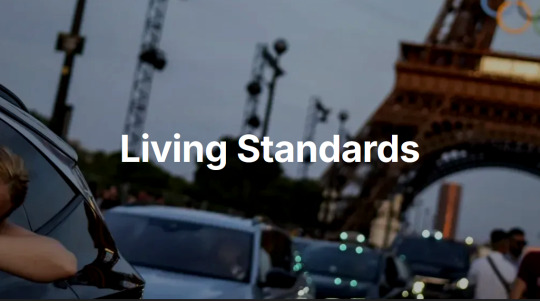
39. Millions more children got an education
Staggering statistics incoming: between 2000 and 2023, the number of children and adolescents not attending school fell by nearly 40%, and Eastern and Southern Africa, achieved gender parity in primary education, with 25 million more girls are enrolled in primary school today than in the early 2000s. Since 2015, an additional 110 million children have entered school worldwide, and 40 million more young people are completing secondary school.
40. We fed around a quarter of the world's kids at school
Around 480 million students are now getting fed at school, up from 319 million before the pandemic, and 104 countries have joined a global coalition to promote school meals, School feeding policies are now in place in 48 countries in Africa, and this year Nigeria announced plans to expand school meals to 20 million children by 2025, Kenya committed to expanding its program from two million to ten million children by the end of the decade, and Indonesia pledged to provide lunches to all 78 million of its students, in what will be the world's largest free school meals program.
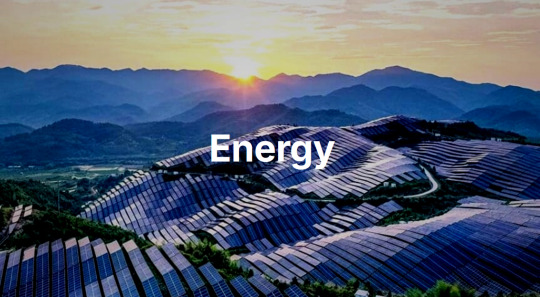
50. Solar installations shattered all records
Global solar installations look set to reach an unprecedented 660GW in 2024, up 50% from 2023's previous record. The pace of deployment has become almost unfathomable - in 2010, it took a month to install a gigawatt, by 2016, a week, and in 2024, just 12 hours. Solar has become not just the cheapest form of new electricity in history, but the fastest-growing energy technology ever deployed, and the International Energy Agency said that the pace of deployment is now ahead of the trajectory required for net zero by 2050.
51. Battery storage transformed the economics of renewables
Global battery storage capacity surged 76% in 2024, making investments in solar and wind energy much more attractive, and vice-versa. As with solar, the pace of change stunned even the most cynical observers. Price wars between the big Chinese manufacturers pushed battery costs to record lows, and global battery manufacturing capacity increased by 42%, setting the stage for future growth in both grid storage and electric vehicles - crucial for the clean flexibility required by a renewables-dominated electricity system. The world's first large-scale grid battery installation only went online seven years ago; by next year, global battery storage capacity will exceed that of pumped hydro.
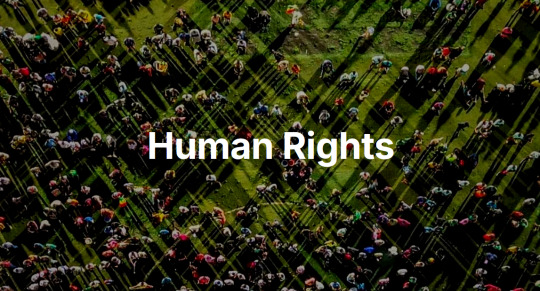
65. Democracy proved remarkably resilient in a record year of elections
More than two billion people went to the polls this year, and democracy fared far better than most people expected, with solid voter turnout, limited election manipulation, and evidence of incumbent governments being tamed. It wasn't all good news, but Indonesia saw the world's biggest one day election, Indian voters rejected authoritarianism, South Korea's democratic institutions did the same, Bangladesh promised free and fair elections following a 'people's victory', Senegal, Sri Lanka and Botswana saw peaceful transfers of power to new leaders after decades of single party rule, and Syria saw the end of one of the world's most horrific authoritarian regimes.
66. Global leaders committed to ending violence against children
In early November, while the eyes of the world were on the US election, an event took place that may prove to be a far more consequential for humanity. Five countries pledged to end corporal punishment in all settings, two more pledged to end it in schools, and another 12, including Bangladesh and Nigeria, accepted recommendations earlier in the year to end corporal punishment of children in all settings. In total, in 2024 more than 100 countries made some kind of commitment to ending violence against children. Together, these countries are home to hundreds of millions of children, with the WHO calling the move a 'fundamental shift.'
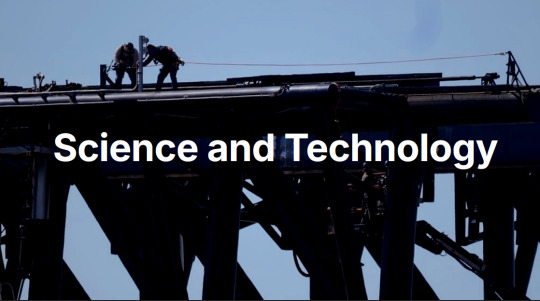
73. Space exploration hit new milestones
NASA’s Europa Clipper began a 2.9 billion kilometre voyage to Jupiter to investigate a moon that may have conditions for life; astronomers identified an ice world with a possible atmosphere in the habitable zone; and the James Webb Telescope found the farthest known galaxy. Closer to Earth, China landed on the far side of the moon, the Polaris Dawn crew made a historic trip to orbit, and Starship moved closer to operational use – and maybe one day, to travel to Mars.
74. Next-generation materials advanced
A mind-boggling year for material science. Artificial intelligence helped identify a solid-state electrolyte that could slash lithium use in batteries by 70%, and an Apple supplier announced a battery material that can deliver around 100 times better energy density. Researchers created an insulating synthetic sapphire material 1.25 nanometers thick, plus the world’s thinnest lens, just three atoms across. The world’s first functioning graphene-based semiconductor was unveiled (the long-awaited ‘wonder material’ may finally be coming of age!) and a team at Berkeley invented a fluffy yellow powder that could be a game changer for removing carbon from the atmosphere.
-via Fix The News, December 19, 2024
#renumbered this to reflect the article numbering#and highlight just how many stories of hope there are#and how many successes each labeled story contains#2024#good news#hope#hope posting#hopeposting#hopepunk#conservation#sustainability#public health#energy#quality of life#human rights#science and technology
3K notes
·
View notes
Text
Emerging Technologies of 2024: What's New and What's Next
Unveiling the Tech Wonders of Today and Tomorrow As we step further into 2024, the technological landscape continues to evolve at an unprecedented pace. Innovations once relegated to the realm of science fiction are now becoming realities, reshaping our lives in profound ways. In this article, we’ll explore some of the most groundbreaking technologies emerging this year and what we can…

View On WordPress
#2024 Technology#5G Networks#AI Innovations#Augmented Reality#Biotechnology Advances#Emerging Technologies#Future Tech Trends#Internet of Things#Quantum Computing#Tech Industry Insights
0 notes
Text
I think I’ve been disappointed by Super Bowl halftime shows ever since Katy Perry set the bar too high in 2015. Like, come on. The aerial entrance? The giant moving light-up tiger? Fricken Left Shark which became a meme. All the outfit changes. Like don’t get me wrong there have been some cool half-time shows since then, but not on Katy Perry’s level.
#where’s the theatrics#the technology#I keep getting my hopes up too high#I want something I can’t take my eyes off of but I just keep getting bored#super bowl#superbowl#super bowl 2024#superbowl 2024#half time show#super bowl halftime show#katy perry#left shark#football#shitpost#relatable#also this isn’t just about Usher I promise#this is something I’ve been thinking every year since 2015
439 notes
·
View notes
Text





ELM Evolv demonstrator, 2024. Prodrive Advanced Technology and Astheimer Design have revealed a ‘last mile’ L7e category electric quadricycle prototype with a cubic load capacity rivalling mid-size vans. At 3,240mm long, 1,450mm wide, 2,150mm high and weighing 850kg with batteries, the compact Evolv can accommodates a 1.6m tall Euro pallet with a 300kg payload in the main load area. The secondary load area, accessible through rear ‘barn doors’, provides additional space for a 1.2m tall Euro pallet and 200kg payload. Prodrive and Astheimer has established a new company, ELM Mobility, to take the project into the production readiness phase. The vehicle, which has a 20kWh battery, will offer a 100 mile range with sales starting in 2028 at a target price of around £25,000.
ELM Mobility
#ELM#ELM Mobility#ELM Evolv#prototype#demonstrator#test vehicle#Prodrive#Prodrive Advanced Technology#Astheimer Design#2024#2028#electric quadricycle#small van#electric van#last mile delivery#micro van#box van#Evolv
152 notes
·
View notes
Photo

A Year in Reading: The Dark Side of Progress
Our Best of 2024 package continues with a year in reading reflection by Longreads publisher Peter Rubin, who shares some thought-provoking reads that explore technology’s influence on humans.
"Living through cultural shifts is an odd experience. You may know at some level that all things are transitory, but you rarely think how “all things” includes the constants and variables of day-to-day life. Then you look back at all the pieces you read and recommended over the past year and realize you’re not just in the middle of one cultural shift—you’re in the middle of many cultural shifts. And they all boil down to the fact that technology and money are rewriting our cultural bedrock.
I know, I know. Duh. But the breadth is still surprising. Name me an area of human experience that feels stable, and I’ll show you a stellar piece of journalism from this year that proves otherwise."
Read the full piece.
136 notes
·
View notes
Text
Day 14: stormy

Day 15: self care💛

Inspo:

#drawtober 2024#my dear hatchet man#alan orion#get drawn#MDHM#mdhm alan#mdhm fanart#the sillies#i know Alan doesn’t get technology but I did it for the meme
77 notes
·
View notes
Text
April 14, Xi'an, China, Shaanxi History Museum, Qin and Han Dynasties Branch (Part 3 – Innovations and Philosophies):
(Edit: sorry this post came out so late, I got hit by the truck named life and had to get some rest, and this post in itself took some effort to research. But anyway it's finally up, please enjoy!)
A little background first, because this naming might lead to some confusions.....when you see location adjectives like "eastern", "western", "northern", "southern" added to the front of Zhou dynasty, Han dynasty, Song dynasty, and Jin/晋 dynasty, it just means the location of the capital city has changed. For example Han dynasty had its capital at Chang'an (Xi'an today) in the beginning, but after the very brief but not officially recognized "Xin dynasty" (9 - 23 AD; not officially recognized in traditional Chinese historiography, it's usually seen as a part of Han dynasty), Luoyang became the new capital. Because Chang'an is geographically to the west of Luoyang, the Han dynasty pre-Xin is called Western Han dynasty (202 BC - 8 AD), and the Han dynasty post-Xin is called Eastern Han dynasty (25 - 220 AD). As you can see here, in these cases this sort of adjective is simply used to indicate different time periods in the same dynasty.
Model of a dragonbone water lift/龙骨水车, Eastern Han dynasty. This is mainly used to push water up to higher elevations for the purpose of irrigation:
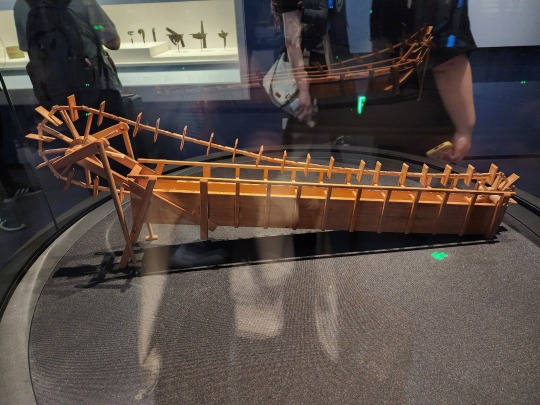
Model of a water-powered bellows/冶铁水排, Eastern Han dynasty. Just as the name implies, as flowing water pushes the water wheel around, the parts connected to the axle will pull and push on the bellows alternately, delivering more air to the furnace for the purpose of casting iron.

The Nine Chapters on the Mathematical Art/《九章算术》, Fangcheng/方程 chapter. It’s a compilation of the work of many scholars from 10 th century BC until 2 nd century AD, and while the earliest authors are unknown, it has been edited and supplemented by known scholars during Western Han dynasty (also when the final version of this book was compiled), then commented on by scholars during Three Kingdoms period (Kingdom of Wei) and Tang dynasty. The final version contains 246 example problems and solutions that focus on practical applications, for example measuring land, surveying land, construction, trading, and distributing taxes. This focus on practicality is because it has been used as a textbook to train civil servants. Note that during Han dynasty, fangcheng means the method of solving systems of linear equations; today, fangcheng simply means equation. For anyone who wants to know a little more about this book and math in ancient China, here’s an article about it. (link goes to pdf)
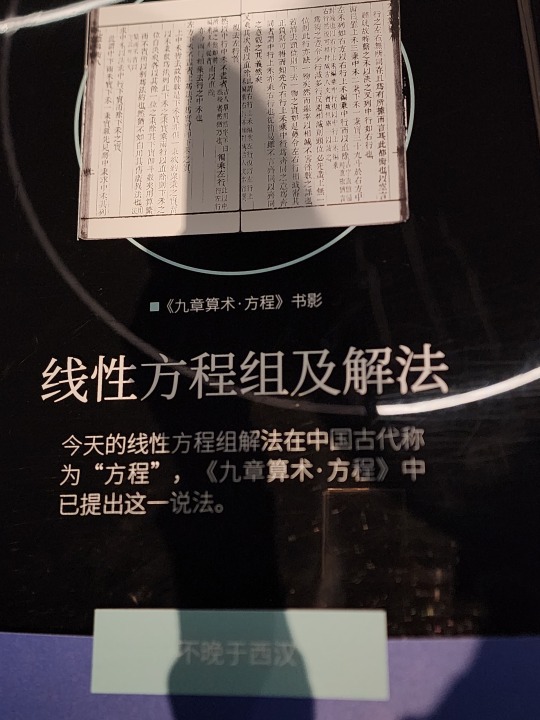
Diagram of a circle in a right triangle (called “勾股容圆” in Chinese), from the book Ceyuan Haijing/《测圆海镜》 by Yuan-era mathematician Li Ye/李冶 (his name was originally Li Zhi/李治) in 1248. Note that Pythagorean Theorem was known by the name Gougu Theorem/勾股定理 in ancient China, where gou/勾 and gu/股 mean the shorter and longer legs of the right triangle respectively, and the hypotenuse is named xian/弦 (unlike what the above linked article suggests, this naming has more to do with the ancient Chinese percussion instrument qing/磬, which is shaped similar to a right triangle). Gougu Theorem was recorded in the ancient Chinese mathematical work Zhoubi Suanjing/《周髀算经》, and the name Gougu Theorem is still used in China today.

Diagram of the proof for Gougu Theorem in Zhoubi Suanjing. The sentence on the left translates to "gou (shorter leg) squared and gu (longer leg) squared makes up xian (hypotenuse) squared", which is basically the equation a² + b² = c². Note that the character for "squared" here (mi/幂) means "power" today.

This is a diagram of Zhang Heng’s seismoscope, called houfeng didong yi/候风地动仪 (lit. “instrument that measures the winds and the movements of the earth”). It was invented during Eastern Han dynasty, but no artifact of houfeng didong yi has been discovered yet, this is presumably due to constant wars at the end of Eastern Han dynasty. All models and diagrams that exist right now are what historians and seismologists think it should look like based on descriptions from Eastern Han dynasty. This diagram is based on the most popular model by Wang Zhenduo that has an inverted column at the center, but this model has been widely criticized for its ability to actually detect earthquakes. A newer model that came out in 2005 with a swinging column pendulum in the center has shown the ability to detect earthquakes, but has yet to demonstrate ability to reliably detect the direction where the waves originate, and is also inconsistent with the descriptions recorded in ancient texts. What houfeng didong yi really looks like and how it really works remains a mystery.
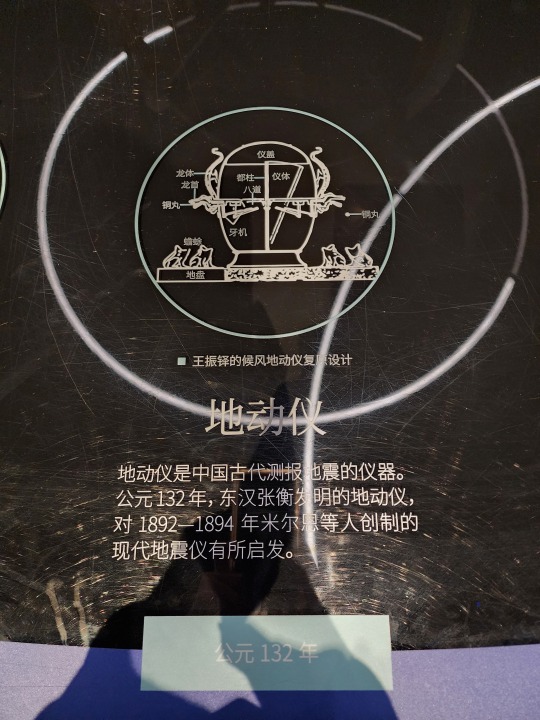
Xin dynasty bronze calipers, the earliest sliding caliper found as of now (not the earliest caliper btw). This diagram is the line drawing of the actual artifact (right).


Ancient Chinese "Jacquard" loom (called 提花机 or simply 花机 in Chinese, lit. "raise pattern machine"), which first appeared no later than 1st century BC. The illustration here is from the Ming-era (1368 - 1644) encyclopedia Tiangong Kaiwu/《天工开物》. Basically it's a giant loom operated by two people, the person below is the weaver, and the person sitting atop is the one who controls which warp threads should be lifted at what time (all already determined at the designing stage before any weaving begins), which creates patterns woven into the fabric. Here is a video that briefly shows how this type of loom works (start from around 1:00). For Hanfu lovers, this is how zhuanghua/妆花 fabric used to be woven, and how traditional silk fabrics like yunjin/云锦 continue to be woven. Because it is so labor intensive, real jacquard silk brocade woven this way are extremely expensive, so the vast majority of zhuanghua hanfu on the market are made from machine woven synthetic materials.

Chinese purple is a synthetic pigment with the chemical formula BaCuSi2O6. There's also a Chinese blue pigment. If anyone is interested in the chemistry of these two compounds, here's a paper on the topic. (link goes to pdf)

A list of common colors used in Qin and Han dynasties and the pigments involved. White pigment comes from chalk, lead compounds, and powdered sea shells; green pigment comes from malachite mineral; blue pigment usually comes from azurite mineral; black comes from pine soot and graphite; red comes from cinnabar; ochre comes from hematite; and yellow comes from realgar and orpiment minerals.

Also here are names of different colors and shades during Han dynasty. It's worth noting that qing/青 can mean green (ex: 青草, "green grass"), blue (ex: 青天, "blue sky"), any shade between green and blue, or even black (ex: 青丝, "black hair") in ancient Chinese depending on the context. Today 青 can mean green, blue, and everything in between.

Western Han-era bronze lamp shaped like a goose holding a fish in its beak. This lamp is interesting as the whole thing is hollow, so the smoke from the fire in the lamp (the fish shaped part) will go up into the neck of the goose, then go down into the body of the goose where there's water to catch the smoke, this way the smoke will not be released to the surrounding environment. There are also other lamps from around the same time designed like this, for example the famous gilt bronze lamp that's shaped like a kneeling person holding a lamp.


Part of a Qin-era (?) clay drainage pipe system:
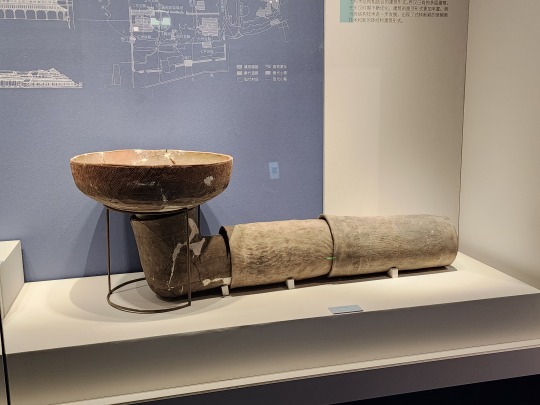
A list of canals that was dug during Warring States period, Qin dynasty, and pre-Emperor Wu of Han Han dynasty (475 - 141 BC). Their purposes vary from transportation to irrigation. The name of the first canal on the list, Hong Gou/鸿沟, has already become a word in Chinese language, a metaphor for a clear separation that cannot be crossed (ex: 不可逾越的鸿沟, meaning "a gulf that cannot be crossed").
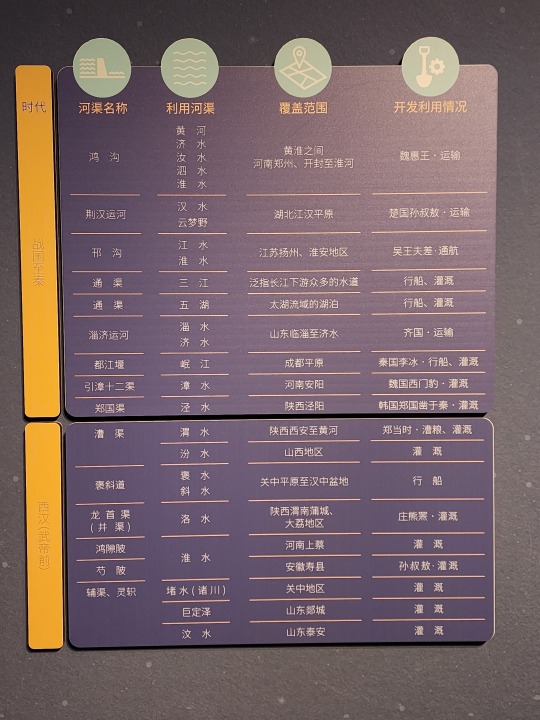
Han-era wooden boat. This boat is special in that its construction has clear inspirations from the ancient Romans, another indication of the amount of information exchange that took place along the Silk Road:

A model that shows how the Great Wall was constructed in Qin dynasty. Laborers would use bamboo to construct a scaffold (bamboo scaffolding is still used in construction today btw, though it's being gradually phased out) so people and materials (stone bricks and dirt) can get up onto the wall. Then the dirt in the middle of the wall would be compressed into rammed earth, called hangtu/夯土. A layer of stone bricks may be added to the outside of the hangtu wall to protect it from the elements. This was also the method of construction for many city walls in ancient China.

A list of the schools of thought that existed during Warring States period, their most influential figures, their scholars, and their most famous works. These include Confucianism (called Ru Jia/儒家 in Chinese; usually the suffix "家" at the end denotes a school of thought, not a religion; the suffix "教" is that one that denotes a religion), Daoism/道家, Legalism (Fa Jia/法家), Mohism/墨家, etc.

The "Five Classics" (五经) in the "Four Books and Five Classics" (四书五经) associated with the Confucian tradition, they are Shijing/《诗经》 (Classic of Poetry), Yijing/《易经》 (also known as I Ching), Shangshu/《尚书》 (Classic of History), Liji/《礼记》 (Book of Rites), and Chunqiu/《春秋》 (Spring and Autumn Annals). The "Four Books" (四书) are Daxue/《大学》 (Great Learning), Zhongyong/《中庸》 (Doctrine of the Mean), Lunyu/《论语》 (Analects), and Mengzi/《孟子》 (known as Mencius).

And finally the souvenir shop! Here's a Chinese chess (xiangqi/象棋) set where the pieces are fashioned like Western chess, in that they actually look like the things they are supposed to represent, compared to traditional Chinese chess pieces where each one is just a round wooden piece with the Chinese character for the piece on top:
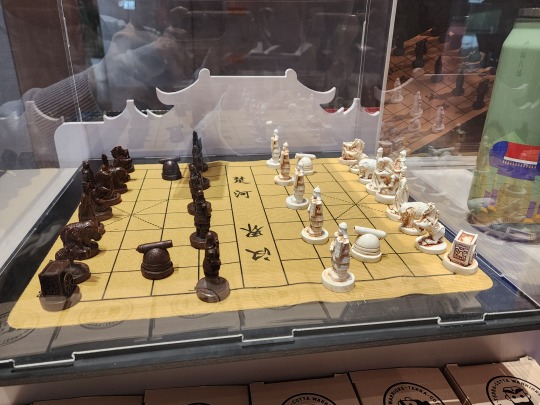
A blind box set of small figurines that are supposed to mimic Shang and Zhou era animal-shaped bronze vessels. Fun fact, in Shang dynasty people revered owls, and there was a female general named Fu Hao/妇好 who was buried with an owl-shaped bronze vessel, so that's why this set has three different owls (top left, top right, and middle). I got one of these owls (I love birds so yay!)


And that concludes the museums I visited while in Xi'an!
#2024 china#xi'an#china#shaanxi history museum qin and han dynasties branch#chinese history#chinese culture#chinese language#qin dynasty#han dynasty#warring states period#chinese philosophy#ancient technology#math history#history#culture#language
91 notes
·
View notes
Text
https://www.slideshare.net/slideshow/partnering-for-growth-top-10-net-development-companies-to-propel-your-business/269641688
#.net development#.net developers#app development#2024 technology#web development#clarion technology#.net framework#technology#developer
0 notes
Text
Rockets, Racecars, and the Physics of Going Fast

When our Space Launch System (SLS) rocket launches the Artemis missions to the Moon, it can have a top speed of more than six miles per second. Rockets and racecars are designed with speed in mind to accomplish their missions—but there’s more to speed than just engines and fuel. Learn more about the physics of going fast:

Take a look under the hood, so to speak, of our SLS mega Moon rocket and you’ll find that each of its four RS-25 engines have high-pressure turbopumps that generate a combined 94,400 horsepower per engine. All that horsepower creates more than 2 million pounds of thrust to help launch our four Artemis astronauts inside the Orion spacecraft beyond Earth orbit and onward to the Moon. How does that horsepower compare to a racecar? World champion racecars can generate more than 1,000 horsepower as they speed around the track.
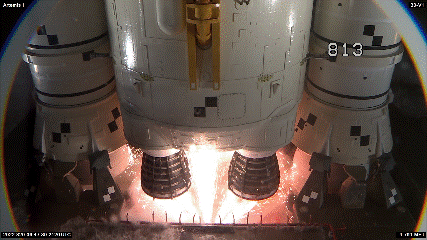
As these vehicles start their engines, a series of special machinery is moving and grooving inside those engines. Turbo engines in racecars work at up to 15,000 rotations per minute, aka rpm. The turbopumps on the RS-25 engines rotate at a staggering 37,000 rpm. SLS’s RS-25 engines will burn for approximately eight minutes, while racecar engines generally run for 1 ½-3 hours during a race.

To use that power effectively, both rockets and racecars are designed to slice through the air as efficiently as possible.
While rockets want to eliminate as much drag as possible, racecars carefully use the air they’re slicing through to keep them pinned to the track and speed around corners faster. This phenomenon is called downforce.

Steering these mighty machines is a delicate process that involves complex mechanics.
Most racecars use a rack-and-pinion system to convert the turn of a steering wheel to precisely point the front tires in the right direction. While SLS doesn’t have a steering wheel, its powerful engines and solid rocket boosters do have nozzles that gimbal, or move, to better direct the force of the thrust during launch and flight.

Racecar drivers and astronauts are laser focused, keeping their sights set on the destination. Pit crews and launch control teams both analyze data from numerous sensors and computers to guide them to the finish line. In the case of our mighty SLS rocket, its 212-foot-tall core stage has nearly 1,000 sensors to help fly, track, and guide the rocket on the right trajectory and at the right speed. That same data is relayed to launch teams on the ground in real time. Like SLS, world-champion racecars use hundreds of sensors to help drivers and teams manage the race and perform at peak levels.

Knowing how to best use, manage, and battle the physics of going fast, is critical in that final lap. You can learn more about rockets and racecars here.
Make sure to follow us on Tumblr for your regular dose of space!
#NASA#Artemis#Moon#Space Launch System#rocket science#space#exploration#Moon 2024#rocket testing#racecar#tech#technology#motorsport
1K notes
·
View notes
Text

LETTERS FROM AN AMERICAN
November 6, 2024
Heather Cox Richardson
Nov 06, 2024
Yesterday, November 5, 2024, Americans reelected former president Donald Trump, a Republican, to the presidency over Democratic candidate Vice President Kamala Harris. As of Wednesday night, Trump is projected to get at least 295 electoral votes to Harris’s 226, with two Republican-leaning states still not called. The popular vote count is still underway.
Republicans also retook control of the Senate, where Democrats were defending far more seats than Republicans. Control of the House is not yet clear.
These results were a surprise to everyone. Trump is a 78-year-old convicted felon who has been found liable for sexual assault and is currently under indictment in a number of jurisdictions. He refused to leave office peacefully when voters elected President Joe Biden in 2020, instead launching an unprecedented attack on the U.S. Capitol to stop the counting of electoral votes, and said during his campaign that he would be a “dictator” on his first day in office.
Pollsters thought the race would be very close but showed increasing momentum for Harris, and Harris’s team expressed confidence during the day. By posting on social media—with no evidence—that the voting in Pennsylvania was rigged, Trump himself suggested he expected he would lose the popular vote, at least, as he did in 2016 and 2020.
But in 2024, it appears a majority of American voters chose to put Trump back into office.
Harris and her running mate, Minnesota governor Tim Walz, offered a message of unity, the expansion of the economic policies that have made the U.S. economy the strongest in the world in the wake of the coronavirus pandemic, and the creation of an “opportunity economy” that echoed many of the policies Republicans used to embrace. Trump vowed to take revenge on his enemies and to return the country to the neoliberal policies President Joe Biden had rejected in favor of investing in the middle class.
When he took office, Biden acknowledged that democracy was in danger around the globe, as authoritarians like Russian president Vladimir Putin and China’s president Xi Jinping maintained that democracy was obsolete and must be replaced by autocracies. Russia set out to undermine the North Atlantic Treaty Organization (NATO) that enforced the rules-based international order that stood against Russian expansion.
Hungarian prime minister Viktor Orbán, who overturned democracy in his own country, explained that the historical liberal democracy of the United States weakens a nation because the equality it champions means treating immigrants, LGBTQ+ individuals, and women as equal to men, thus ending traditionally patriarchal society.
In place of democracy, Orbán champions “illiberal democracy,” or “Christian democracy.” This form of government holds nominal elections, although their outcome is preordained because the government controls all the media and has silenced opposition. Orbán’s model of minority rule promises a return to a white-dominated, religiously based society, and he has pushed his vision by eliminating the independent press, cracking down on political opposition, getting rid of the rule of law, and dominating the economy with a group of crony oligarchs.
In order to strengthen democracy at home and abroad, Biden worked to show that it delivered for ordinary Americans. He and the Democrats passed groundbreaking legislation to invest in rebuilding roads and bridges and build new factories to usher in green energy. They defended unions and used the Federal Trade Commission to break up monopolies and return more economic power to consumers.
Their system worked. It created record low unemployment rates, lifted wages for the bottom 80% of Americans, and built the strongest economy in the world in the wake of the coronavirus pandemic, setting multiple stock market records. But that success turned out not to be enough to protect democracy.
In contrast, Trump promised he would return to the ideology of the era before 2021, when leaders believed in relying on markets to order the economy with the idea that wealthy individuals would invest more efficiently than if the government regulated business or skewed markets with targeted investment (in green energy, for example). Trump vowed to cut taxes for the wealthy and corporations and to make up lost revenue through tariffs, which he incorrectly insists are paid by foreign countries; tariffs are paid by U.S. consumers.
For policies, Trump’s campaign embraced the Project 2025 agenda led by the right-wing Heritage Foundation, which has close ties to Orbán. That plan calls for getting rid of the nonpartisan civil service the U.S. has had since 1883 and for making both the Department of Justice and the military partisan instruments of a strong president, much as Orbán did in Hungary. It also calls for instituting religious rule, including an end to abortion rights, across the U.S. Part of the idea of “purifying” the country is the deportation of undocumented immigrants: Trump promised to deport 20 million people at an estimated cost of $88 billion to $315 billion a year.
That is what voters chose.
Pundits today have spent time dissecting the election results, many trying to find the one tweak that would have changed the outcome, and suggesting sweeping solutions to the Democrats’ obvious inability to attract voters. There is no doubt that a key factor in voters’ swing to Trump is that they associated the inflation of the post-pandemic months with Biden and turned the incumbents out, a phenomenon seen all over the world.
There is also no doubt that both racism and sexism played an important role in Harris’s defeat.
But my own conclusion is that both of those things were amplified by the flood of disinformation that has plagued the U.S. for years now. Russian political theorists called the construction of a virtual political reality through modern media “political technology.” They developed several techniques in this approach to politics, but the key was creating a false narrative in order to control public debate. These techniques perverted democracy, turning it from the concept of voters choosing their leaders into the concept of voters rubber-stamping the leaders they had been manipulated into backing.
In the U.S., pervasive right-wing media, from the Fox News Channel through right-wing podcasts and YouTube channels run by influencers, have permitted Trump and right-wing influencers to portray the booming economy as “failing” and to run away from the hugely unpopular Project 2025. They allowed MAGA Republicans to portray a dramatically falling crime rate as a crime wave and immigration as an invasion. They also shielded its audience from the many statements of Trump’s former staff that he is unfit for office, and even that his chief of staff General John Kelly considers him a fascist and noted that he admires German Nazi dictator Adolf Hitler.
As actor Walter Masterson posted: “I tried to educate people about tariffs, I tried to explain that undocumented immigrants pay billions in taxes and are the foundation of this country. I explained Project 2025, I interviewed to show that they supported it. I can not compete against the propaganda machines of Twitter, Fox News, [Joe Rogan Experience], and NY Post. These spaces will continue to create reality unless we create a more effective way of reaching people.”
X users noted a dramatic drop in their followers today, likely as bots, no longer necessary, disengaged.
Many voters who were using their vote to make an economic statement are likely going to be surprised to discover what they have actually voted for. In his victory speech, Trump said the American people had given him an “unprecedented and powerful mandate.”
White nationalist Nick Fuentes posted, “Your body, my choice. Forever,” and gloated that men will now legally control women’s bodies. His post got at least 22,000 “likes.” Right-wing influencer Benny Johnson, previously funded by Russia, posted: “It is my honor to inform you that Project 2025 was real the whole time.”
Today, Trump campaign press secretary Karoline Leavitt said Trump would launch the “largest mass deportation operation” of undocumented immigrants, and the stock in private prison companies GEO Group and CoreCivic jumped 41% and 29%, respectively. Those jumps were part of a bigger overall jump: the Dow Jones Industrial Average moved up 1,508 points in what Washington Post economic columnist Heather Long said was the largest post-election jump in more than 100 years.
As for the lower prices Trump voters wanted, Kate Gibson of CBS today noted that on Monday, the National Retail Federation said that Trump’s proposed tariffs will cost American consumers between $46 billion and $78 billion a year as clothing, toys, furniture, appliances, and footwear all become more expensive. A $50 pair of running shoes, Gibson said, would retail for $59 to $64 under the new tariffs.
U.S. retailers are already preparing to raise prices of items from foreign suppliers, passing to consumers the cost of any future tariffs.
Trump’s election will also mean he will no longer have to answer to the law for his federal indictments: special counsel Jack Smith is winding them down ahead of Trump’s inauguration. So he will not be tried for retaining classified documents or attempting to overthrow the U.S. government when he lost in 2020.
This evening, Hungarian prime minister Viktor Orbán posted on social media that he had just spoken with Trump, and said: “We have big plans for the future!”
This afternoon, Vice President Kamala Harris spoke at her alma mater, Howard University, to concede the election to Trump.
She thanked her supporters, her family, the Bidens, the Walz family, and her campaign staff and volunteers. She reiterated that she believes Americans have far more in common than separating us.
In what appeared to be a message to Trump, she noted: “A fundamental principle of American democracy is that when we lose an election, we accept the results. That principle as much as any other distinguishes democracy from monarchy or tyranny, and anyone who seeks the public trust must honor it. At the same time in our nation, we owe loyalty not to a president or a party, but to the Constitution of the United States, and loyalty to our conscience and to our God.
“My allegiance to all three is why I am here to say, while I concede this election, I do not concede the fight that fuels this campaign, the fight for freedom, for opportunity, for fairness and the dignity of all people, a fight for the ideals at the heart of our nation, the ideals that reflect America at our best. That is a fight I will never give up.”
Harris urged people “to organize, to mobilize and to stay engaged for the sake of freedom and justice and the future that we all know we can build together.” She told those feeling as if the world is dark indeed these days, to “fill the sky with the light of a billion brilliant stars, the light of optimism, of faith, of truth and service,” and to let “that work guide us, even in the face of setbacks, toward the extraordinary promise of the United States of America.”
LETTERS FROM AN AMERICAN
HEATHER COX RICHARDSON
#Letters From An American#Heather cox Richardson#election 2024#TFG#the flood of disinformation#political technology#right wing media
58 notes
·
View notes
Text
















【Part 3】 ◠‿◠ Women shopping ... terrible XD hahaha
「廣西桂林好聚落」: "若生靜巷 coffee shop" & "一顆橄欖"專賣店
若生靜巷咖啡 (@umarekawatta.coffee)地址:高雄市前鎮區桂林街58巷18號 時間:10:00~18:00、週一、週四公休 電話:(07)334-5685
一顆橄欖 UNE OLIVE EN PROVENCE (一顆橄欖好生活Uneolivetw) 地址:高雄市前鎮區桂林街58巷10號 時間:週二至週日9:00~17:00 電話:(07)331-6800
#chu lan#fine craft artist#朱蘭皮藝#leather art artist#beautiful life#to see ai innovation technology exhibition#kaohsiung#taiwan#高雄展覽館#2024 meet greater south 亞灣新創大南方展#創新科技xtree創新x亞灣5g alot#經濟部產業技術司#解密科技寶藏#my life my way#tea time with vivian#一顆橄欖好生活une olive en provence /taiwan
85 notes
·
View notes
Text

These are going to be very inconsistent ...
#alek art#ninjago#zane julien#lloyd garmadon#jay walker#nya smith#kai smith#and ...#cole#2024#these are all different time frames (i can't remember what happens when lol) ...#zane post ice emperor has super long hair ... sometimes i give kai golden eyes ... sometimes i give lloyd red ones ... everything is fake 🙏#also i keep changing my mind on zane's design / how his body itself works#i think his first body could bleed ... but now it's all metal . i give him a 'human' face plate though .#because dr julien is a very different designer than everyone else who has worked on him . more natural versus more technology . also he has#brown eyes thank you . ive started thinking about how their powers could affect them (based off how lloyd's eyes go green)#zane gets glassy eyes and looks like hes died after too long . kai has burn scars (not pictured hure) . if you touch jay you have a 75%#chance of being electrocuted and a 0.5% chance of never waking up from that#here*** crazy typo
59 notes
·
View notes
Text



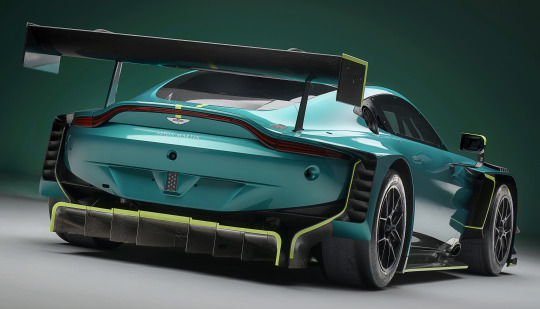
Aston Martin Vantage GT3, 2024. Alongside the new Vantage AML have revealed the racing version that will compete in GT series, including the FIA World Endurance Championship, IMSA WeatherTech SportsCar Championship and the Fanatec GT World Challenge.
#Aston Martin#Aston Martin Vantage GT3#2024#race car#track car#endurance racing#Aston Martin Racing#Aston Martin Performance Technologies
239 notes
·
View notes